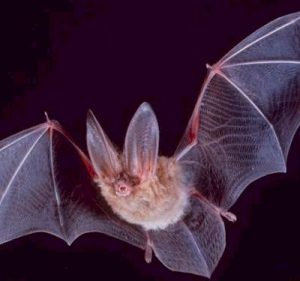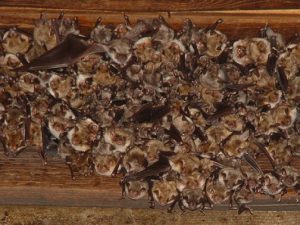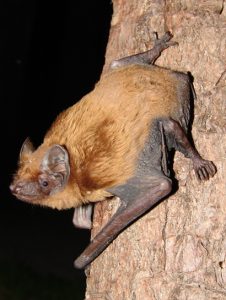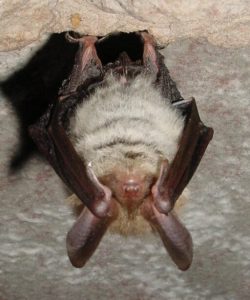Bats in the spotlight: winners or losers?

‘Wait, I’ll show you something!’ We are standing on a balcony, looking over the bush at night. Viktor, our South African host turns on a spotlight at the side of his house. We don’t have to wait long before we see a shadow flitting through the beam. A bat hunts for insects at the light. Soon it is joint by another one and we marvel at their beautiful flight.

You don’t have to travel to South Africa to see bats hunting at lights. Worldwide, bats have discovered artificial light as a source for a quick snack. Each night, noctule bats, pipistrelles and house bats make use of the high insect abundance at street and house lights. Drawn in by the bright light like by a vacuum cleaner, insects buzz around blindly. Some moths even loose their natural defense mechanisms against bats and become an easy prey. Good times for the little flying mammals.
But there are some bats that do not profit from light. For bats, light is linked to the presence of day-active birds of prey. So slow-flying bat species like mouse-eared bats, long-eared bats, horseshoe bats and Botta’s serotine avoid it.
Such differences in the reaction to light can influence the bat species in an area. Illuminated areas provide good feeding conditions for light-tolerant species, while light-avoiding species will not use these areas for hunting. Unfortunately, insects are drawn out of the dark areas to the lights, leaving the slow-flying bats in a secure, but rather insect-deprived darkness.

But that’s not the end of the problem. Today’s bats find it hard to secure suitable roosts. Often they can be found in churches, where bats are not necessarily welcomed because of their droppings. It also becomes more and more common to illuminate churches, with dramatic consequences for the inhabitants.
It has been shown that bats roosting in illuminated churches leave later in the evening. This reduces the amount of time that can be used for foraging, but also excludes bats from the best hunting times: insect abundance is highest in the evening hours. The loss of food is worst for pregnant and nurturing females. They usually fly out later than the other bats, and have higher energy requirements. It has been shown for mouse-eared bats that juveniles in illuminated roosts were lighter and smaller than their peers without artificial light.

In some cases, roosts have been abandoned completely. This was the case for one of the biggest colonies of mouse-eared bats in Hungary, containing 1000 to 1200 females after an outdoor illumination had been installed. Similar observations have been made in Sweden, where 35 per cent of all colonies of the brown long-eared bat had been abandoned since 1980. All abandoned churches had been equipped with outdoor lights in the meantime.
For some bats, light can even be deadly. Karl Kugelschafter reports the death of several thousand mouse-eared bats after the lights have been left on inside a church.

You think that’s bad enough? There’s more: Researchers at the Leibniz-Institute for Zoo and Wildlife Research in Berlin have shown that migrating Nathusius’ bats and Soprano bats are attracted by green light. Migrating bats eat little on their journey, so it seems these bats did not come for the insects, but for the light itself, although this meant a considerable detour and a loss of time and energy for flying around the light. Energy, that is needed for their long journey over the Baltic Sea.
Bats are known for their ability to fly in the dark, using echolocation to find obstacles and prey. However, bats flying in light stop using their echolocation and switch to visual. This seems to be a disadvantage in today’s world, because many bats collide with illuminated structures like radio towers. The mammal eye is not adjusted to fast changes in light intensity, and contact with a concentrated, bright light can blind parts of the eye for up to 10 minutes. So, from a bat’s point of view, security spot lights might be more dangerous than skyglow or moon light.
Many bat species, including all 22 species native to Germany, are endangered. To survive, bats need a good supply of insects, suitable hunting areas like small water bodies and undisturbed roosting sites. These things are hard to get in modern civilisation. In addition, many bats die in traffic or are killed by people who fear them or see them as pests. Now they face another threat: the loss of their chrono habitat, the night, due to artificial light. Though it appears that some species profit from nocturnal illumination, British bat researcher Fiona Mathews is not convinced. In her research, she was not able to find real advantages for light-tolerant species. Additionally, in the long run, food might get sparse when insects disappear from the menu.

More than enough reasons to consider bats whenever you or your town plan artificial lights. There are several things to help bats here, and the best part is, all these things also help other species and us humans: Make sure the lights are directed to where they are needed and are shielded towards the sky and the surrounding. Use warm light, which is less attractive to insects. Reduce light intensity to the needed minimum and switch off or dim the lights if you don’t need them. Bat-friendly lights are especially important close to forests, water bodies and bat roosts. Therefore, every town should really consider not to illuminate its church or castle. Bats deserve our protection. Not only because they are enchanting little spirits of the night, but also because they are important assistants in fighting insect pests in agriculture.